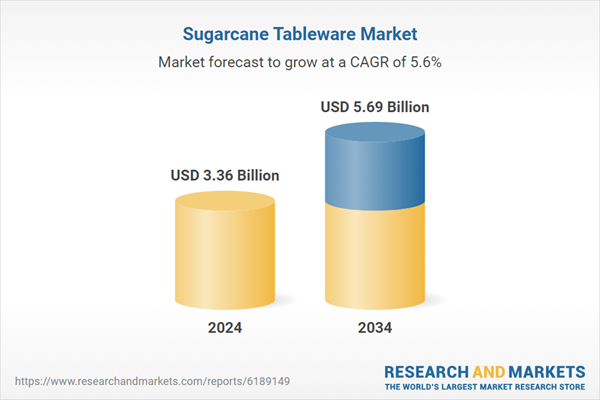The Global Sugarcane Tableware Market was valued at USD 3.36 billion in 2024 and is estimated to grow at a CAGR of 5.6% to reach USD 5.69 billion by 2034.
The market growth is closely tied to the rapid expansion of the global foodservice industry, fueled by rising urbanization, evolving lifestyles, and the growing popularity of quick-service restaurants, cloud kitchens, and online food delivery platforms. As consumers increasingly prioritize convenience and hygiene, demand for disposable and eco-friendly packaging continues to rise. Sugarcane tableware, which is biodegradable and compostable, has emerged as a sustainable replacement for traditional plastic and foam-based disposables. It supports the environmental goals of foodservice brands striving to reduce their ecological footprint and comply with sustainability-driven regulations. The use of sugarcane bagasse, a fibrous by-product of sugar extraction, transforms agricultural waste into a renewable material for disposable products. This approach not only mitigates waste but also provides a scalable supply of eco-friendly alternatives for global foodservice operations. As regulatory standards tighten and consumer preferences shift toward green solutions, the adoption of sugarcane-based tableware is expected to accelerate in both developed and emerging markets.
In 2024, the plates and trays segment generated USD 1.25 billion. These products dominate due to their versatility and widespread use across foodservice formats, including institutional catering, fast food, and dining establishments. Their broad and durable design allows them to hold a range of food items from dry to semi-liquid while maintaining convenience and hygiene. The single-use nature of plates and trays makes them particularly well-suited to high-volume and fast-paced food environments, supporting efficiency and quick turnover without compromising quality or presentation. Their compostable and heat-resistant properties further enhance their value for sustainable foodservice applications.
The disposable segment held 67% share in 2024. The growing preference for single-use, compostable tableware reflects consumers’ desire to balance convenience with sustainability. Made from sugarcane bagasse fibers, these disposable products serve as an environmentally sound alternative to petroleum-based plastics. Their biodegradability and compostable attributes make them ideal for catering services, institutional dining, and takeout operations that emphasize safety, cleanliness, and waste reduction. Consumers who want to reduce their environmental footprint without sacrificing practicality are increasingly gravitating toward these products, reinforcing their market leadership across foodservice channels.
United States Sugarcane Tableware Market held 78.2% share and generated USD 0.73 billion in 2024. The U.S. market’s strong position is supported by progressive environmental regulations and bans on single-use plastics in several states, driving demand for sustainable alternatives. This regulatory landscape, combined with heightened awareness of compostable certifications, is encouraging adoption across restaurants, retail outlets, and institutions. American consumers particularly those in urban, environmentally conscious areas are more inclined to choose biodegradable tableware options that align with their eco-friendly values. The convergence of policy support and consumer awareness continues to propel market growth across the country.
Key players operating in the Global Sugarcane Tableware Market include GreenGood, Pactiv Evergreen, BioMass Packaging, EcoSave, Natural Tableware, Huhtamaki Group, Bio Futura B.V., PalmLeaf Tech, Hefty Tableware, Biotrem, Vegware, Eco-Products, Sustainable Earth, Green Paper Products, Eco Guardian, Enviroware, Sabert, and Rousselot Biomedical.
To strengthen their market position, leading companies are implementing strategies focused on innovation, capacity expansion, and sustainability. Many are investing in advanced manufacturing processes to enhance product strength, heat resistance, and compostability. Partnerships with foodservice chains and retailers are helping improve brand visibility and distribution networks. Companies are also prioritizing eco-certifications and compliance with global environmental standards to build consumer trust.
Comprehensive Market Analysis and Forecast
- Industry trends, key growth drivers, challenges, future opportunities, and regulatory landscape
- Competitive landscape with Porter’s Five Forces and PESTEL analysis
- Market size, segmentation, and regional forecasts
- In-depth company profiles, business strategies, financial insights, and SWOT analysis
This product will be delivered within 2-4 business days.
Table of Contents
Companies Mentioned
The companies profiled in this Sugarcane Tableware market report include:- Bio Futura B.V.
- BioMass Packaging
- Biotrem
- Eco Guardian
- Eco-Products
- EcoSave Private
- Enviroware
- Green Paper Products
- GreenGood
- Hefty Tableware
- Huhtamaki Group
- Natural Tableware
- Pactiv Evergreen
- PalmLeaf Tech
- Sabert
- Sustainable Earth
- Vegware
Table Information
| Report Attribute | Details |
|---|---|
| No. of Pages | 250 |
| Published | October 2025 |
| Forecast Period | 2024 - 2034 |
| Estimated Market Value ( USD | $ 3.36 Billion |
| Forecasted Market Value ( USD | $ 5.69 Billion |
| Compound Annual Growth Rate | 5.6% |
| Regions Covered | Global |
| No. of Companies Mentioned | 18 |









